|
|
|
|
|
|
|
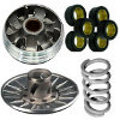
click on the image
for the presentation |
VARIATOR DESIGN
the features of the variator are fundmental
to obtain the maximum from the engine power, but are
also the most difficult to find, in fact the operation
of the variator depends from many elements , that must
to be coupled
adequately to get the continuous variation of the
transmission more effective for the engine and the vehicle. Thanks to the
software Variator Design you can see how changes the vehicle performance,
acting on all the elements that make up the variator,
so you can easily find the solution that lets you
get the maximum performance based on the characteristics of the
engine. |
|
|
|
|
How it works?
|
The software
Variator Design allows to see how the choices of the
various elements of the variator affect the performance of the vehicle
(speed, acceleration, etc.) in function of the engine power curve, allowing you therefore to find with ease the
best solutions for your needs.
|
To be able to make the best choices is necessary that the
calculation is very precise, for this reason
the software Variator Design
takes into account of all the factors that influence the
performance. |
| - vehicle weight |
- wheels axle inertia |
| - aerodynamic drag |
- weather conditions |
| - rolling resistance |
- vehicle balance |
| - engine inertia |
- grip level |
|
The operation of the software is very easy.
For first you must enter the data
of the engine power curve. The power curve can be
measured with dynotest, or can
be calculated directly from the
software Variator Design entering the data acquired
from your acquisition system in a session on track.
Together to this you must enter the
type of engine (2S or 4T),
and if you know them, the values of the
crankshaft inertia, and of the
auxiliaries mounted (pulley, flywheel,
ignition system, etc.).
|
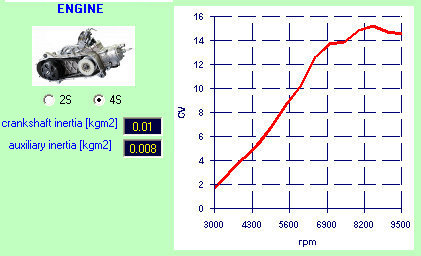 |
You must then enter the informations
of the vehicle, and of the driving wheels. In
addition to the total weight of the vehicle with rider,
must be inserted, the frontal area, and the diameter of the
wheels. The values of aerodynamic drag, of the rolling
resistance, and of the wheels inertia, if aren't known can be derived from the examples present in the software for all the main vehicles with variator (scooter,
quad, minicar, etc.)
|
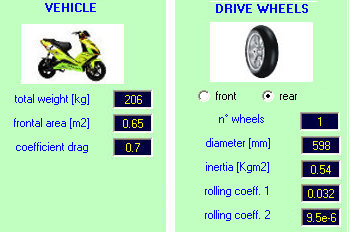 |
| These data are sufficient to perform the calculation
assuming that the adherence allows to exploit all the engine
power, but the software Variator Design
allows also to perform the calculation taking account of the
real adherence avalaible, in this way you can make
the choices of the gear ratios also on the basis of this
important factor. It will be enough
enter in the software also the data relatives to the gravity
of the vehicle, and to the grip level. |
 |
| If between the variator and the wheel there is also a
fixed gear transmission, in the software is possible to
enter these gear ratios. Moreover in this area you can
enter, if you know it, the inertia of the shaft of the
clutch pulley. |
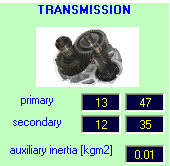 |
|
At this point you must enter the characteristics of the
variator, which can be modified until you find the optimal
solution to get the maximum performance from the vehicle and
fully exploit your engine. |
| The software
Variator Design allows to define easily all the features of
the variator that affect the operation, so will be possible
to act on each element to see how it affects the performance
and to find the best solution. |
For first you must enter the standstill geometry of the
variator, therefore:
- starting diameter drive pulley
- starting diameter clutch pulley
- wheelbase pulleys |
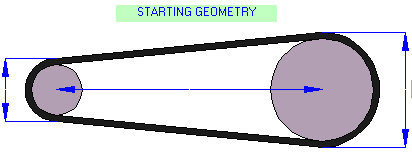 |
After you must enter the geometry of the drive pulley:
- rollers scrolling position and profile
- fixed plate shape and angle
- distance plate semi-pulley
You must enter also the features of the belt:

- width
- angle |
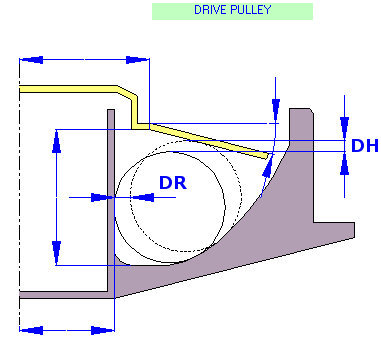 |
Moreover you must enter the characteristics of the
torque corrector on the clutch pulley:
- diameter helicoidal guide
- angle helicoidal guide |
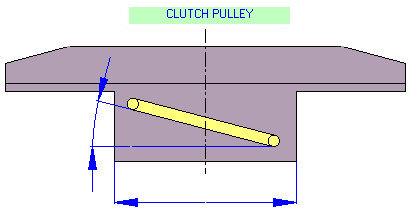 |
At this point you must enter the features of the
elements that you can easily modify on the variator, the
rollers, and the contrast spring.
| For the rollers: |
For the spring: |
- diameter
- weight
- number |
- preload
- stiffness
|
|
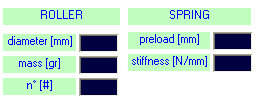 |
|
Results |
| At the end of the calculation the software Variator
Design you show how the variator changes the transmission ratio, and gives its value at the differents speed. Morevoer you show the time
to reach the differents speed. In this way
you can have a complete picture of the choices made, also
to compare the differents solutions that you want testing. |
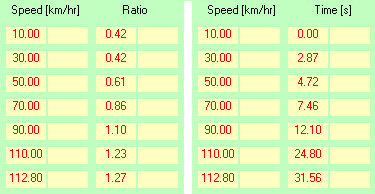 |
| In addition to
the global data, the software shows you the
graphs in
function of the time of all the of all the quantities of
main interest to evaluate the performance, therefore
the progress of the engine speed,
of the speed, and of the
acceleration,
in function of the time. Furthermore you show
how changes the transmission ratio during the acceleration. This allows you to evaluate the performance in all
the phases, being able to analyze in detail the
more suitable choices for the variator. |
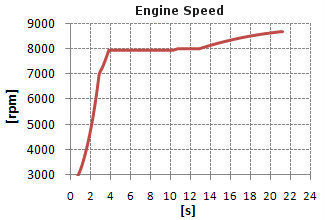 |
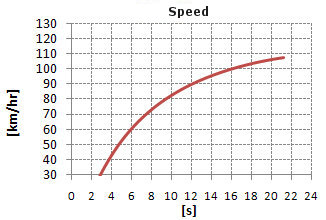 |
 |
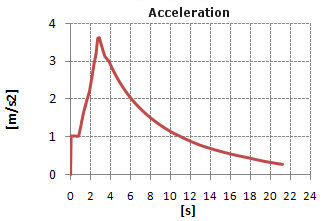 |
| OPTIMAL ROLLER |
The software Variator Design allows to find
the optimal weight of the variator rollers, in fact allows to
compare the performance with differents solutions, and therefore to
easily find the more adapted for your needs.
For the example in the case of the images, the new rollers (blue)
allow to have a better performance. In fact in
this case the maximum speed is reached with a time
significantly lower, and in general the whole phase of
acceleration is more competitive. |
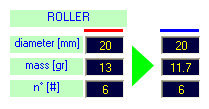 |
 |
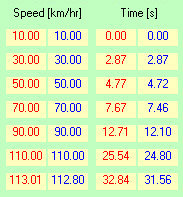 |
|
OPTIMAL PRELOAD and SPRING |
| Together to the choice of the rollers, other aspect
very important is the choice of the
contrast spring, and of the preload,
above all track by track. The software Variator Design allows
you to see how changes the performance in function of the spring features,
so you can know in base
at the different springs, which choice can be better for the
different situations. |
 |
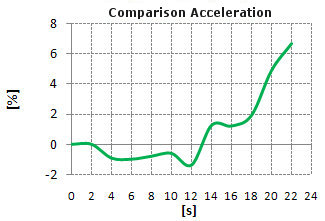 |
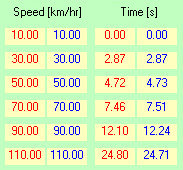 |
| In the case of the images, the new spring, and the new preload, given
a worsening of the acceleration
in the central phase, but after a consistent improvement, therefore
thanks at this information will be easy to make the best choice
in function of the features of the track. |
| OPTIMAL ROLLERS SCROLLING PROFILE |
|
In the examples shown above you have seen the use of the
software to obtain an optimal set-up of the variator, then
by intervening on the elements that are easy to replace, but
the software Variator Design can also be used during the
design of the variator, or to change radically the
characteristics of the variator, in fact it is possible to
study a different profile on which the rollers scroll. |
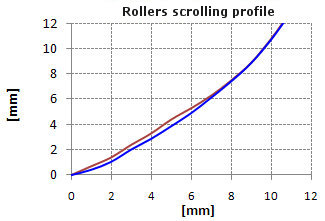 |
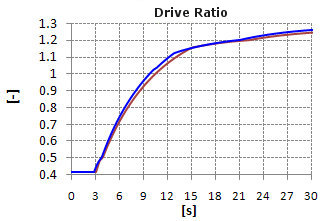 |
 |
|
In the case of the images the new scrolling profile (red)
that gives a faster rise of the roller in the starting phase,
determines an improvement of the performance, all
however it is related to the characteristics of the engine, and what is the
optimal value must be assessed on a case-by-case basis,
thanks to the software Variator Design you can
make the best choice specific for your engine and your vehicle. |
| OPTIMAL TORQUE CORRECTOR |
|
As for the rollers scrolling profile, the choice of the
torque corrector characteristics significantly influences
the behavior of the variator. Thanks to the software
Variator Design also this aspect can be assessed easily and
safely. |
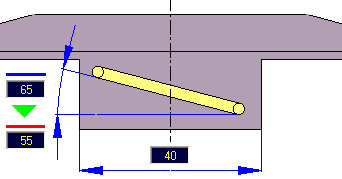 |
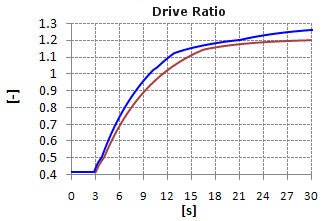 |
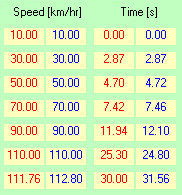 |
In the case shown, the new torque corrector (red) determines
a more homogeneous variation of the transmission ratio
during the acceleration phase, and this leads to an
improvement in performance up to almost the maximum speed.
Also from this example you can see how
thanks to the
software Variator Design is possible to find many solutions
for the variator, both in setup phase, both in design
and development phase, that allow to
improve the performance in function of your needs and
to exploit at the best your engine based on the
characteristics of the vehicle and its use.
|
| OPTIMAL SET-UP
FOR DIFFERENTS RIDER WEIGHT |
As we have seen according to the characteristics of the
engine and of the vehicle, thanks to the software Variator
Design, is possible to find the best solutions for the
variator to achieve the maximum performance, in addition to
this, the software can also be used to differentiate the
variator set-up in based on the weight of the rider, in
fact often happens to have riders of different weight, and
therefore is important to see if the choices made for the
variator are optimal for both riders, or it is necessary a
different setup.
|
 |
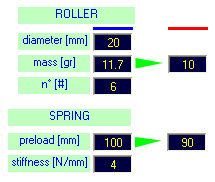 |
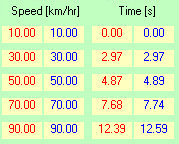 |
|
In the case shown by intervening on the variator set-up, an
improvement compromise has been found which reduces the loss
of acceleration due to the greater weight of the rider. |
| OPTIMAL SET-UP
AFTER ENGINE TUNING |
|
If you make engine tuning that modifies the power curve of
the engine, the set-up and the characteristics of the
variator that had been identified as better, may require
modifications. Thanks to the software Variator Design, by
inserting the new power curve and working on the different
calibration elements of the variator, you can easily see if
there is a better solution than the previous one to make the
most of the new power curve. |
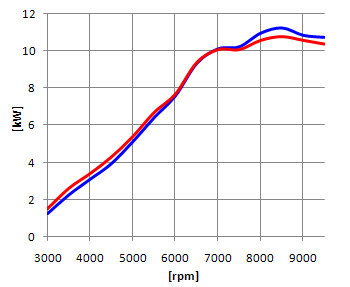 |
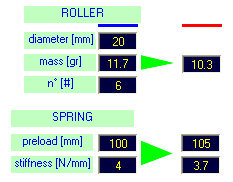 |
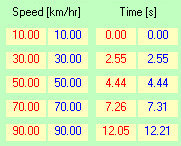 |
|
In the case shown, thanks to the software it is possible to
work on the variator set-up until finding a solution that
better adapts to the new power curve of the engine,
obtaining advantages on the performance of the vehicle. |
Obviously every engine and every vehicle require differents choices,
for this reason the help of the software
Variator Design is essential, and allows you to find the
best solutions to make the most of the
different power curves, but also to
better meet the different needs that there are in function of
the competition, at the track, or of the
driving style of the rider.
|
| |
Purchase |
|
|
|
|
NT-PROJECT - Ferrara (Italy)
- info@ntproject.com |
tutto il
materiale contenuto nel presente sito è coperto dalle leggi sul diritto d'autore ©
2005/19 |
|